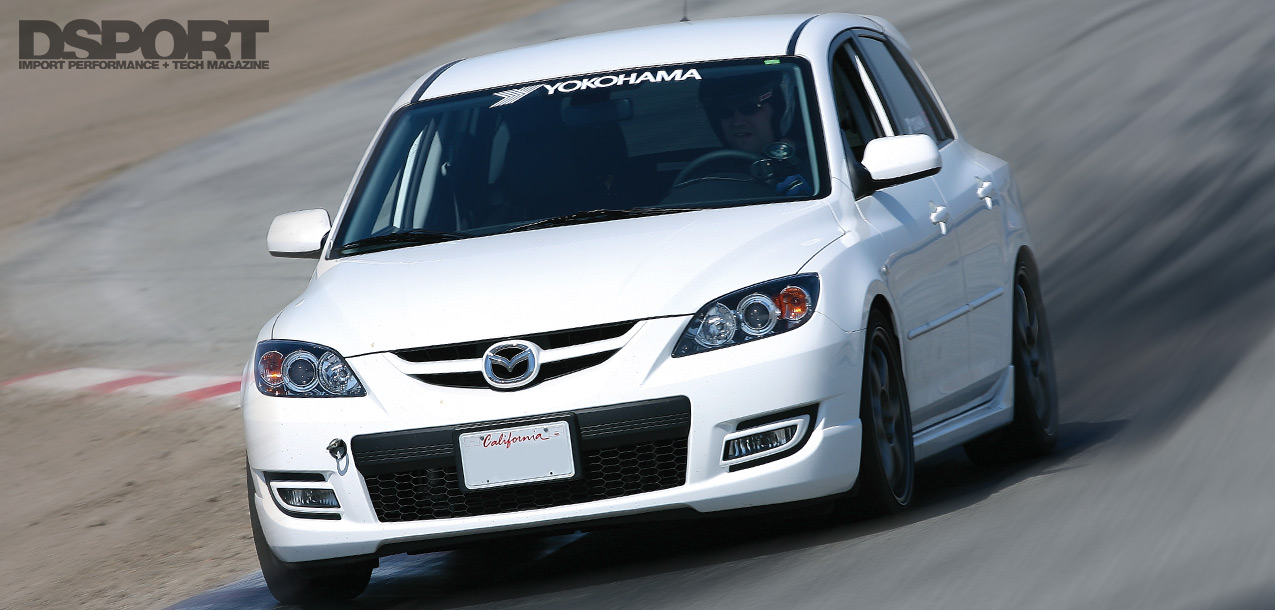The Dyno
On its maiden run on MD Automotive’s Dynojet dynamometer, the MAZDASPEED3 laid down 241.22 horsepower and 269.94 lb-ft of torque to the wheels. According to Mazda, the MAZDASPEED3 is rated at 263 horsepower and 280 lb-ft of torque. Either the MAZDASPEED3 has extremely low driveline loss (8 percent) or Mazda has significantly underrated the power output of the engine. Since we’ve never seen a driveline that efficient, it’s many times more likely that the MAZDASPEED3’s engine actually produces closer to 284 horsepower at the flywheel in stock form.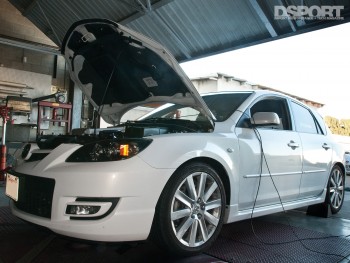
242.22 WHP
266.94 LB-FT TQ
Test 1: CP-E 3-inch Exhaust
After a proper cool down, we went to work on removing the factory exhaust system. Consequently, we found that the quickest way to remove the factory exhaust was to use a Sawzall to cut it into two pieces. The reason is that Mazda designed the exhaust system to sit above the rear suspension. If we wanted to save the factory exhaust, we would have to completely remove the rear subframe that holds the rear suspension. Not wanting to take the chance of creating any issues, we elected for the easy way out. If you cut the factory exhaust system in two, removing it is straightforward. The CP-E system comes in two pieces making installing the system much easier. Once installed, the Mazda was strapped back on the dyno. This time the MAZDASPEED3 generated 244.19 horsepower and 270.07 lb-ft of torque. The 3-inch exhaust made a little over two peak horsepower. A closer inspection of the dyno curve reveals gains as high as six horsepower. This indicates that the factory exhaust system was pretty well designed for the stock horsepower levels. Had we changed the exhaust system after performing other modifi- cations first, we would have likely seen larger gains.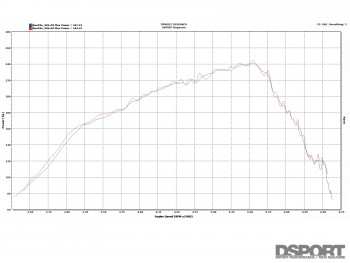
244.19 WHP
270.07 LB-FT TQ
The CP-E 3-inch exhaust system reduced exhaust back pressure, allowing the turbo to reach full boost much quicker. On the dyno, gains as high as six horsepower can be seen on the graph. We were surprised to not see more horsepower from the larger diameter system. However, according to CP-E, the power gains we saw on our MAZDASPEED3 were right in line of their testing.
Test 2: CP-E Xcel Intake
Installing the intake required removing the driver side front wheel and fenderliner to gain access behind the bumper. This is where the new air filter resides. The factory airbox is held in place by a couple of 10mm bolts and must be removed to install the CP-E intake system. When installing the CP-E intake pipe, be sure to take notice of the shifter mechanism’s relation- ship to the intake pipe. Make sure that the shifter is able to go through all the gears without hitting the pipe before tightening down all the nuts and bolts. On the dyno the MAZDASPEED3 roared to life for 253.97 horsepower and 290.15 lb-ft of torque. Peak horsepower increased by 9.8 ponies while increases as high as 20 horsepower were seen at 4,250 RPM.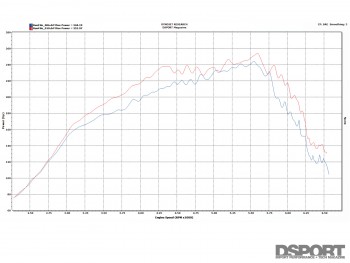
253.97 WHP
290.15 LB-FT TQ
Intake air restriction on a turbocharged powerplant can dramatically affect overall performance. By improving airflow into the turbocharger, boost response and power increase can be realized. The CP-E intake dramatically improved power output of the Mazda throughout the powerband. The largest power gain was witnessed at 6,000 RPM with a gain of 20 horsepower over the stock intake box. Peak horsepower increased by 9.8.
Test 3: CP-E 3-inch Downpipe
Installing the CP-E downpipe is no easy task. Removing the factory downpipe requires removal of the intercooler, several heat shields, two oxygen sensors, a number of mounting brackets and several nuts and bolts that are tucked in next to the firewall. Even after letting the engine cool for 10 minutes and having a huge dyno fan blow on the downpipe, we still ended up searing some skin off our arms. Once the factory downpipe was off, it took us half the time to install the CP-E downpipe. Fortunately, the hard work paid off. With the CP-E downpipe in place, the Mazda rocked the rollers to the tune of 273.32 horsepower and 294.11 lb-ft of torque. Peak horsepower increased by 19.75 while a 36 horsepower gain was seen at 5,100 RPM.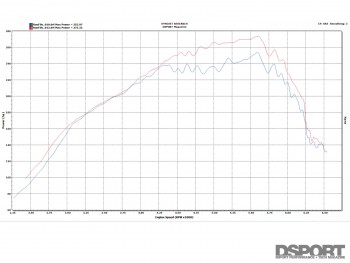
273.32 WHP
294.11 LB-FT TQ
To further increase the exhaust flow, a CP-E 3-inch downpipe was used. Installation is somewhat difficult due to the tight work space. The hard work does pay off big though. The expedited exhaust flow resulted in a gain of 19.35 peak horsepower over the stock downpipe. The largest power increase came at 5,100 RPM with a gain of 36 horsepower to the wheels.


